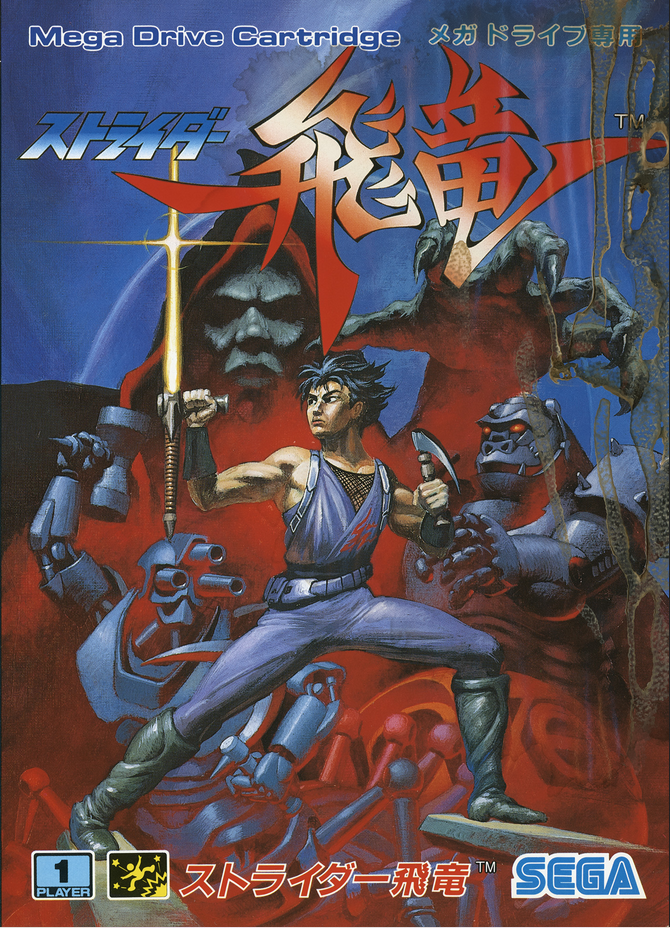
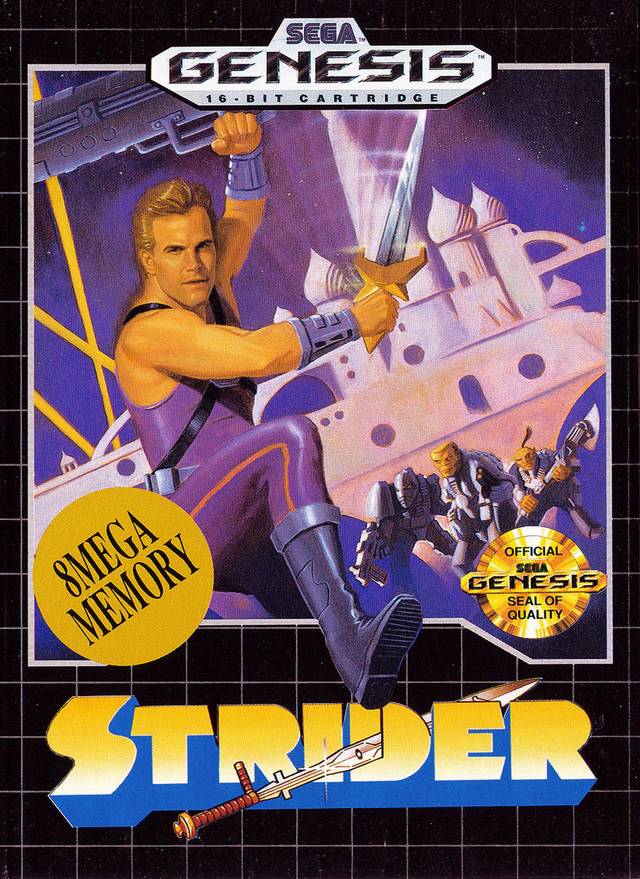
PLAYERS: 1
PUBLISHER: Sega
DEVELOPER: Capcom (port by Sega)
GENRE: Action
RELEASE DATE: 09/29/90 – (JP), 11/90 – (US), 05/91 – (EU)
Since its arcade release in 1989, Strider‘s cult status has reached near-Earthbound levels. Champions of the game declare that it’s one of the best action titles ever made, with each level being an overwhelming tour-de-force of ridiculousness. Detractors claim that the game’s relentless pace makes for an overly hard, unfair experience. Both groups are right, to an extent. I’ve never played an action game that was so intent on pummeling me with its creativity. That said, there are no places to rest in Strider and the last two stages are absolute hell until you memorize the enemy placement.

Ultimately, though, Strider‘s too crazy to not appreciate. Like Revenge of Shinobi before it, it delights in surprising the player with one outlandish set piece after another. In the breadth of a single stage, you’ll fight off packs of Siberian wolves, destroy a ten-foot tall mechanical gorilla, clamber down a mine-riddled mountain, avoid electric transformers that fill the screen with deadly lightning, jump from helicopter to helicopter while avoiding falling bombs, and take on a deadly Chinese martial arts trio.
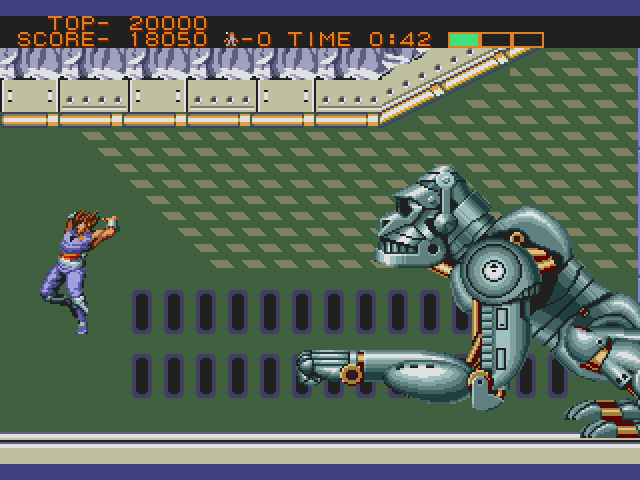
In 2048 A.D., a European nation known as Kazafu (which looks suspiciously like the U.S.S.R.) is toppled by an unknown army. Soon, the entirety of Europe is leveled, along with North and South America by this mysterious force. The cretin behind the destruction? Grand Master Meio, who resembles Emperor Palpatine’s cousin, twice removed. Only Hiryu of the Strider forces can stop Meio on his Third Moon Base, and bring peace to Earth once more.
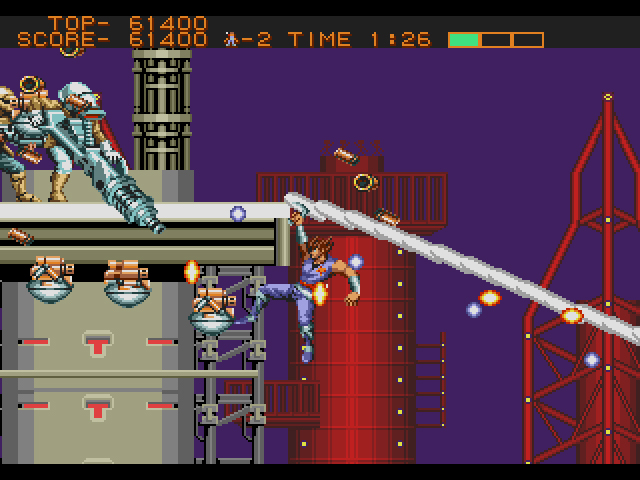
Like the aforementioned Siberia stage, each of Strider‘s four other stages is a triumph of relentless, absurd action. In Kufazu, you slice-and-dice a bodybuilder, dart across the Kremlin-esque rooftops, and eliminate the entire corrupt Kufazu government after they morph into a metallic flying centipede. Within the recesses of the Ballog Battleship, the Anti-Gravity boss removes your ability to stand upright and spins you recklessly around it. In the Amazon, you swing on sagging, bouncy vines, subdue the Amazon women, and leap from dinosaur to dinosaur. And on the Third Moon base, you fight the levitating Grand Master Meio from high atop his skeletal watchtower.
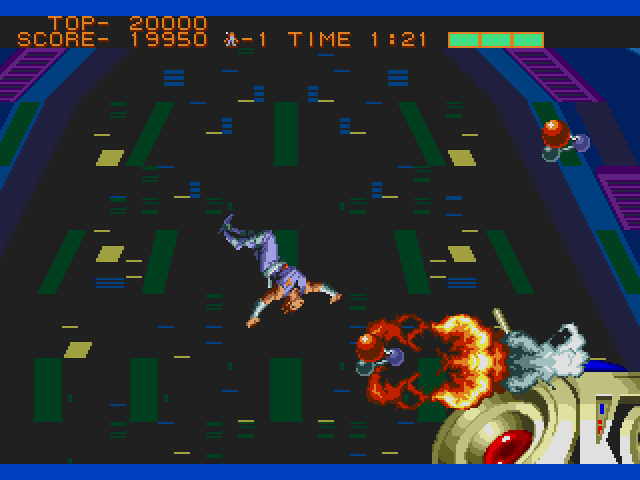
These stages would be impossible to complete if Strider Hiryu wasn’t one of the most elegant heroes in gaming history. He can grease slide along any surface, cartwheel through the air, and grapple onto ceilings and walls, all while slicing enemies in quick succession with his plasma sword. Such an agile creature might seem difficult to control, but his actions are incredibly intuitive. Strider’s one weakness? A single hit tumbles him backwards like a ragdoll, where he could, depending on the level, fall to his death.
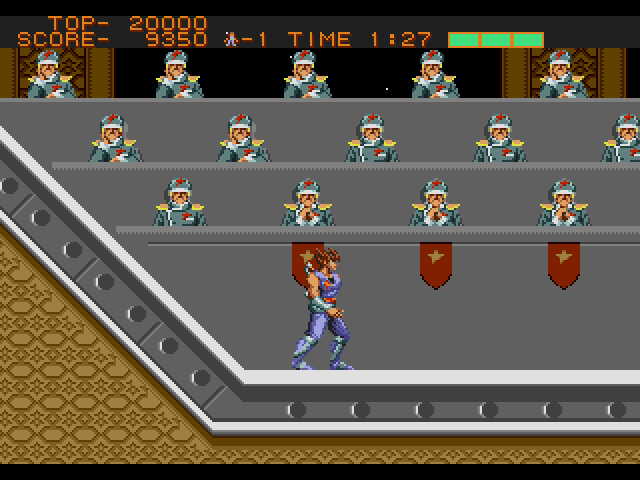
Strider doesn’t just rely on his swanky ninja ensemble and nimble moves to get by. Canisters containing items are everywhere, sometimes on the ground, sometimes dropped by flying enemies. The items run the gamut from worthless (nobody cares about bonus points, Capcom) to necessary, like a stronger sword attack, invincibility, and extra life bars.

The canisters can also contain three robot helpers, all of which are useful to varying degrees. The Dipodal saucers are the most common, cute little creatures that go out of their way to attack enemies. You can have up to two of them, and once you enlist their help, one of your life bar blocks will turn red. The Terapodal Robo-panther is as cool as his name suggests, and appears only when two of the blocks in your life bar have turned red. He unfortunately only hunts by your side for a limited time, and after he’s gone, your Dipodal buddies will return. The Hawk Robot circles above you and destroys anything it touches, though it also disappears after a short while.
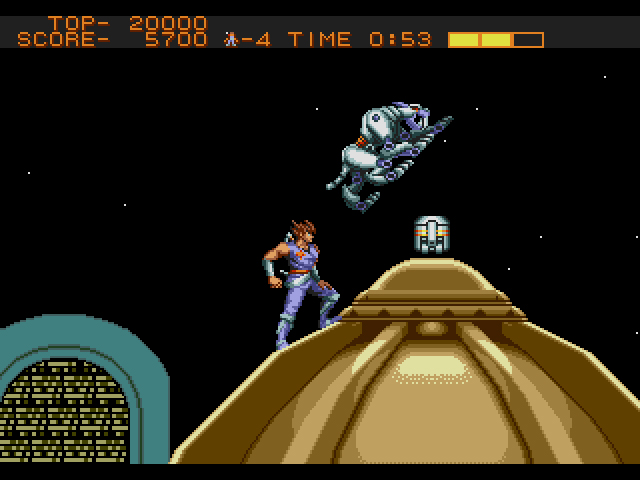
Strider is, without a doubt, one of the best looking games I’ve seen on the Genesis thus far. Strider’s enormous, gorgeously rendered sprite and fluid animations exceed even that of Michael Jackson’s in Moonwalker. The detailed stage designs and backgrounds immerse you into each stage’s unique world. While not all bosses and enemies look and move as beautifully as the main character, their thoughtful, creative design is tailored to each stage and only enhances your journey.
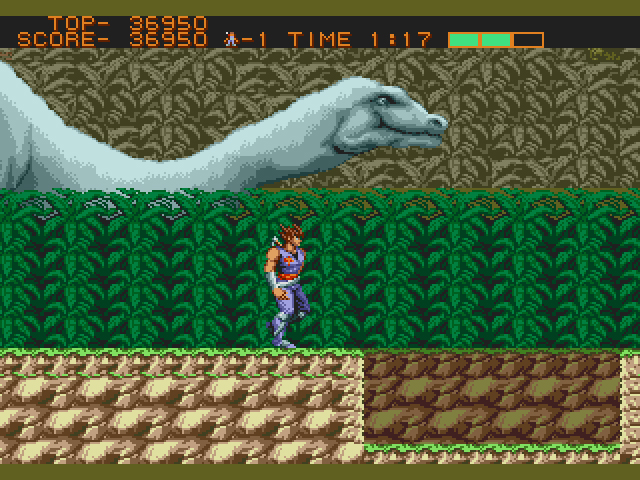
Capcom deserves praise for creating Strider for their now legendary CPS1 arcade system, but Sega should be equally commended for reprogramming the game for the Genesis. Outside of a reduced color palette and a touch of slowdown, the port is considered the finest of Strider‘s many home conversions. Given Capcom’s high standard of quality for console titles, they probably could have assembled a decent port. At the time of Strider‘s release, however, the company had yet to develop any games for the Mega Drive (Ghouls ‘N Ghosts was also handled by Sega). Perhaps it was for the best that Sega took the reins.
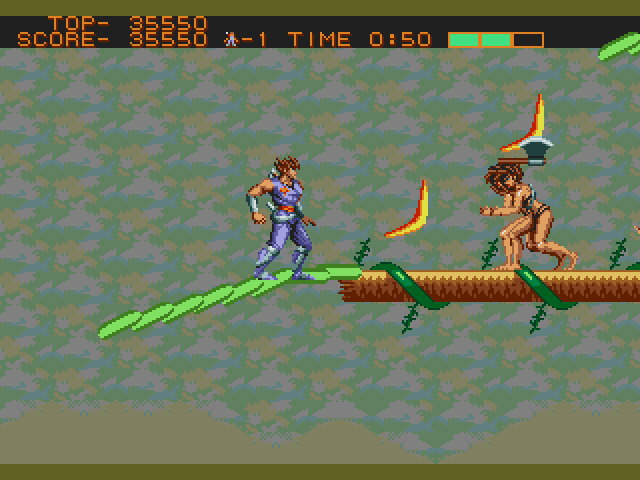
Not all is well in Strider’s house of blood and metal. Each stage has certain areas where you will be hit. The Anti-Gravity boss, for example, will throw you against the ground, and there’s nothing you can do about it. Given Strider’s small life bar – three bars at the least, five at the most – cheap shots aren’t exactly appreciated. On the opposite end of the complaining spectrum, while Strider‘s challenge will probably set you back at first, once you get a feel for the character’s movements and the stage layouts, it’s easy to fly through the game. Unless you just like showing off how much of a badass you are to your friends, Strider carries little replay value.
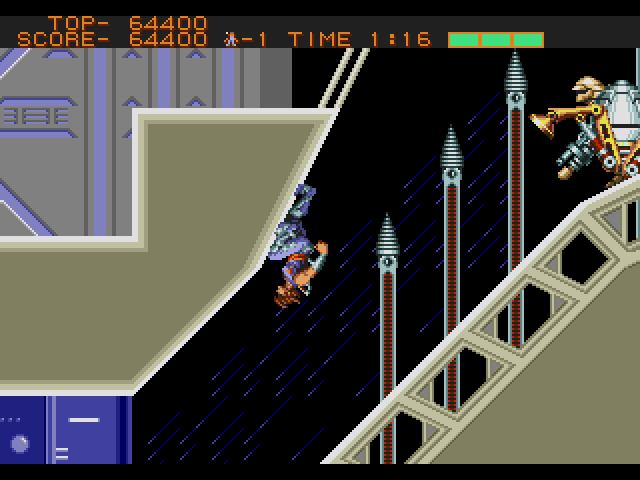
Strider‘s failings are nothing compared to what it does well. Games just didn’t come more epic and intense in 1990. Surprisingly, it still looks and plays like a dream nearly three decades later. All respect to the recent Strider reboot and Strider II from the late PS1-era, but nothing compares to the original’s kinetic beauty. If you grew up during the 80s and 90s, no excuses. Strider is a must-play treasure.
A
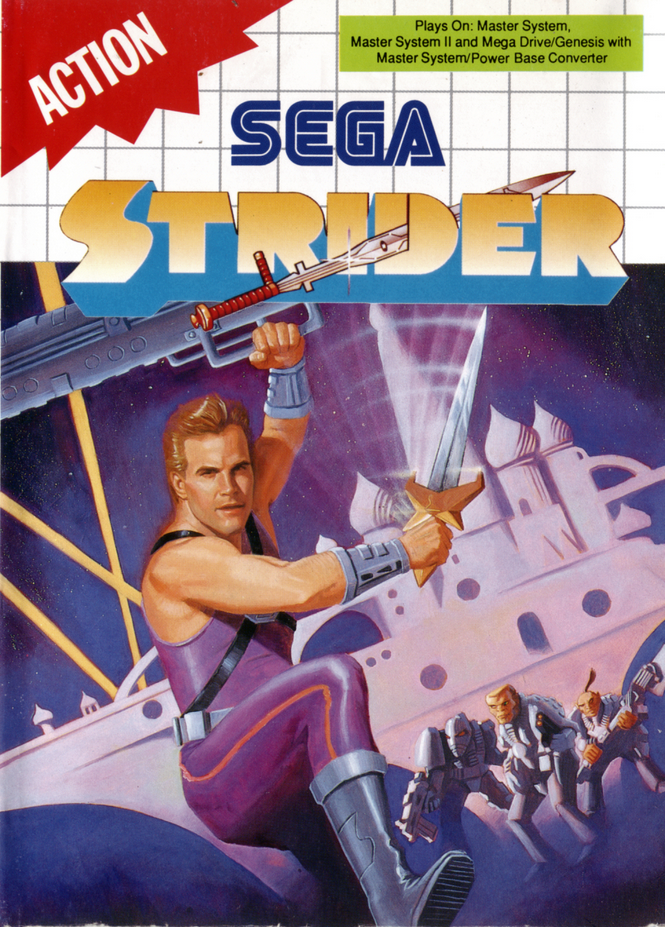
PLAYERS: 1
PUBLISHER: Sega
DEVELOPER: Capcom (port by Sega)
GENRE: Action
RELEASE DATE: 11/91 – (EU)
I’m not surprised that Sega brought Strider to the Master System, but I am surprised that it’s not the worst game I’ve ever played. Compared to previous arcade-to-Master System ports like Forgotten Worlds and Golden Axe – both of which looked and ran like garbage, despite their downgraded existence – Strider is playable, if not the least of the Sega ports.
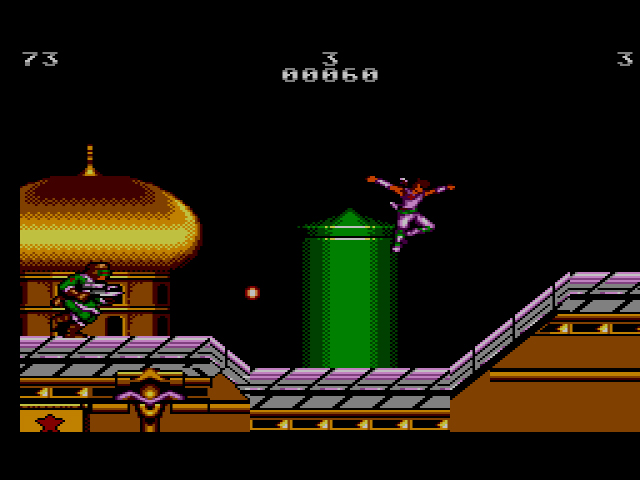
Rather than attempt to recreate Strider in full, Sega wisely took into account the Master System’s limitations. The stages are shortened and on-screen enemies have been considerably reduced, to the point where the levels almost feel empty (most of the bosses are still present). Any background details have been omitted in favor of a black or blue screen that represents the time of day. Strider can still climb walls, hang from platforms, and somersault through the air, but his sliding move has been removed. His life bar too was removed in favor of a number that shows how many times he can be hit.

If Master System Strider is remembered for anything, it’s for the serious slowdown and the easy difficulty. Strider can’t walk, leap, or attack without looking like he’s starring in some John Woo-directed slow-motion scene, sans doves. Perhaps because of the choppy movements, Sega toned down the difficulty. If you’re careful, you can clear the game in fifteen minutes, and that’s with Sega disposing of continues.
If you loved the arcade Strider, saving up for a Mega Drive and the 16-bit port would’ve been the way to go in 1991. Still, kudos to Sega for bringing a neutered version of Strider to the Master System’s surprisingly large fanbase. You can’t say they don’t care.
C

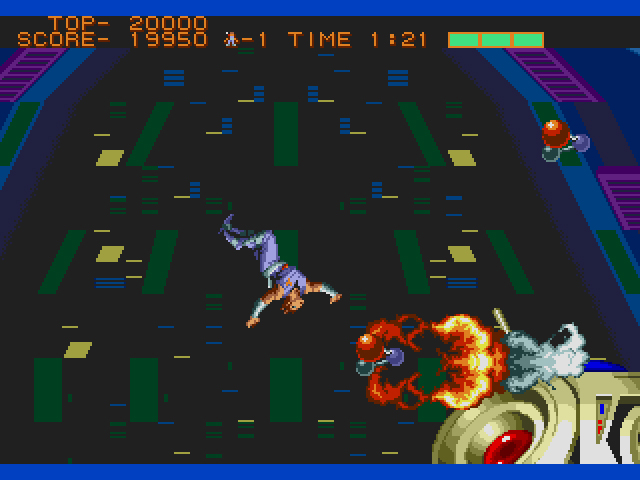
17 replies on “Strider (GEN/MS, 1990-91)”
Well, I guess I need to stop making excuses then. I used to stop in at a 7-11 on my walk home from school in 1991 just to watch the demo sequences on the Strider arcade machine there. I’ve never played it though – little 12yo me was always intimidated by how hard it looked. I’ve been meaning to remedy that for many years.
Awesome Japanese box art – with the amount of coverage Strider gets in Retro Gamer magazine, I can’t believe I’ve never seen it before.
Adult Rom should definitely get his hands on a copy!
Challenge accepted!
Dat Fabio Cover(TM) is the best cover.
Great game – agree with what you said, Strider is tough but definately worth playing. The comparison to Revenge of Shinobi is spot on – both games are very graceful and addictive but really challenging at the same time. I haven’t played Strider in years, hoping to get the Capcom Classics Collection on PSP at some point so I can experience it again.
I never realised how bad the European/US box art was either…Another resounding victory for Japanese box art!
So glad that the US doesn’t have to deal with terrible box art like we used to in the 90s… oy.
Both of the Capcom Classics Collections on PSP are excellent, and I highly recommend them. The arcade port of Strider plays well on the handheld.
This game is one of my favorite games of all time. I spent countless hours in the arcade playing this game, which was far ahead of its time. It really tells a story in a very cinematic way. And manages to just keep throwing one intense action setpiece after another at you. I mean the giant gorilla robot would be a level boss in some games, here it just is a foe you must fight in a corridor to pass. There were voiced cutscenes in a very comic book style giving flavor to the story. Actually it’s more flavor than story. I just loved this game.
As far as the Genesis port, I couldn’t have been happier when this was announced. And for the most part, brings the arcade game home. Taking most of the arcade with it. Maybe it’s missing some of the voices in the cutscenes. But the gameplay is spot on. Like Ghouls N Ghosts, it passes the test of a good port for me that after mastering the game at home, I was able to go to the arcade and maybe beat it in two quarters. Something I had never been able to accomplishing before. It plays just like the arcade.
I believe this game won game of the year from EGM. It certainly was the most impressive home console game by the end of 90. It does have its faults. For one it is an arcade game and the difficulty scales accordingly. Not much was changed for the home release. So once you master and beat it the replay value does go down. But what a trip it is. The final level has some infuriating segments, meant to eat your quarters, but once you figure out what you are supposed to do, it’s not too hard. The final boss will eat up some lives for sure, but is not impossible.
I also love the reoccurring characters like the rocket powered bounty hunter. (“I gotcha”). The memorable lines, and the level progression. Also not known much is the difficulty scales depending on how good your doing. You may have a few bombs dropping on parachutes on the helipocter ride to the airship or screenloads of them. The fight against the three Chinese female ninjas may end in seconds or you could get your ass kicked with advanced patterns. You’ll face more enemies on certain sections if your doing really well.
Another thing to note is the arcade ending is slightly different. It ends with you handgliding done to the ocean and landing on the back of a whale and swimming away on its back! Very stylish.
Thanks as always for sharing your thoughts/memories, Sean.
I had no idea about the scaling difficulty. Never saw that in any of my research for the game! Maybe that explains why I did so well, haha.
This is such a beautiful game. I never saw it in the arcades so my first time playing it was when I rented it. I had heard all the hype leading up to its release and I was certainly not disappointed. I bought this game as soon as I could and was able to complete it.
I do think you’re being a little unfair to the MS version. It’s a great game as well. I don’t think it’s fair to compare it to the 16 bit version. To me it’s one of the best 8-bit games I’ve played and certainly not a C.
I recommend playing the two back-to-back… there’s really no comparison. As I mentioned in the review, I’m just surprised that MS Strider wasn’t complete crap.
I’ve still never seen an arcade cabinet for this, but as much as Sega pushed Strider during their marketing for the “Genesis Does What Nintendon’t” campaign, I was sucked in and bought a copy. I wasn’t disappointed, as it turned out to be quite the ride. I agree that the replay value isn’t there once you beat the game, but just the act of getting to the end and beating it was punishing enough that it would likely take all but the most hardened action platformer player some time to accomplish. I remember it took me months of dedicated play to see the final stage, and probably a couple weeks after that to finally take down Grand Master Meio. It’s a glorious feeling, however, given the game’s utter difficulty. But as I said, it’s quite the ride, and the absolute nonsensical 80’s action movie plot and set pieces make it worth the price of admission. I’m surprised you didn’t mention Grand Master Meio’s maniacal laughter: not only is it one of the better voice samples among early Genesis games, but it’s also hilariously over the top and entertaining. I would agree that it’s among the more essential early Genesis titles, and honestly still holds up pretty well. I should revisit it at some point…
I got you!
https://youtu.be/V8cHR5tppRQ
I always enjoyed the overlapping voice samples. As if you were listening in on a conversation or radio chatter.
Strider was one of my first MegaDrive games and it was glorious. I loved the huge sprites the music. The anti gravity boss blew my mind. Sadly, I have never had the chance to play the arcade version except emulated.
Anyone who likes Strider should definitely check out it’s spiritual successor: Osman / Cannon-Dancer: https://en.m.wikipedia.org/wiki/Osman_(video_game)
Its a fantastic action game that still plays really well. There’s also an anti gravity boss, and you can choose the order in which to tackle certain bosses. The moves set is a lot bigger, even including a slide-grab-throw move. But the main feature of this game is that you can get multiple shadows that mimic your every move. These can be placed strategically to do damage while you keep a safe distance. The game is harder than strider though, but well worth your time.
Woah, never knew about Osman. Looks cool! Thanks, Elmar.
Another game in the Strider vein is Run Saber on the SNES, but it’s a rare title and extremely expensive. It’s apparently pretty good, though.
I need all the Striders I can get!